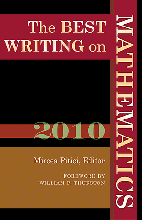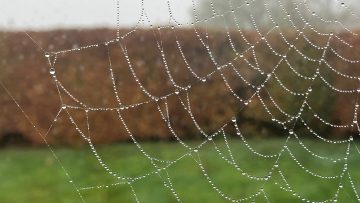Edited by Mircea Pitici (with a foreword by William P. Thurston)
PRINCETON UNIVERSITY PRESS 2010, 360 PAGES
PRICE (PAPERBACK) £13.95, ISBN 978-0-691-14841-0
 After reading this wonderfully crafted book, I put pen to paper somewhat apprehensively to write a review of the ‘best writing’. The book is divided into six parts; Mathematics Alive, Mathematics and the Practice of Mathematics, Mathematics and its Applications, Mathematics Education, History and Philosophy of Mathematics and Mathematics in the Media, offering a selection of articles by various authors publish during 2009. With such a great diversity of writing I found myself loving some of the articles, reading others with interest and skipping swiftly over a few, purely due to personal interest and nothing to do with the quality of the article itself. That’s the beauty of the book, you can pick out what appeals to you.
After reading this wonderfully crafted book, I put pen to paper somewhat apprehensively to write a review of the ‘best writing’. The book is divided into six parts; Mathematics Alive, Mathematics and the Practice of Mathematics, Mathematics and its Applications, Mathematics Education, History and Philosophy of Mathematics and Mathematics in the Media, offering a selection of articles by various authors publish during 2009. With such a great diversity of writing I found myself loving some of the articles, reading others with interest and skipping swiftly over a few, purely due to personal interest and nothing to do with the quality of the article itself. That’s the beauty of the book, you can pick out what appeals to you.
The editor gives the opportunity for these articles to be accessible, to a wider audience as initially they have been published in Journals, magazines and books and only read within the scientific community. The articles are open to a wide readership and someone who has studied mathematics A-level would have no problem understanding the content.
The writings look behind the scenes at some of today’s key mathematical questions, delving into the history, philosophy, teaching, and everyday occurrences of mathematics.
Freeman Dyson writes in his article ‘Birds and Frogs’ taken from his AMS Einstein Lecture,
Some mathematicians are birds, others are like frogs. Birds fly high in the air and survey broad vistas of mathematics out to the far horizon…Frogs live in the mud below and see only the flowers that grow nearby. They delight in the details of particular objects, and they solve problems one at a time.
He goes on to argue that both types of mathematicians are needed by society to develop new mathematical ideas.
‘Desperately Seeking Mathematical Proof’ is written by Melvyn B. Nathanson and was first published in Mathematical Intelligencer. It looks at how we decide a proof is a proof and when it is not. The article uses interesting mathematical stories to enable the reader to form their own personal debate on this issue. Such as the story about Norbert Wiener teaching a class at MIT,
Wiener wrote something on the blackboard and said it was ‘obvious’. One student had the temerity to ask for a proof. Wiener started pacing back and forth, staring at what he had written on the board, saying nothing. Finally, he left the room, walked to his office, closed the door, and worked. After a long absence he returned to the classroom. ‘It is obvious’, he told the class, and continued his lecture.
Nathanson also looks at Erdős’ idea of ‘proofs from the Book’ and how Erdős believed that there was a book which would contain a perfect (brilliantly short simple) proof for every theorem. These proofs would be ‘angel proofs’ in that the theorem would be instantaneously understandable and obviously true from just a glance.
From personal interest I was fascinated by Theodore P. Hill’s article ‘Knowing When to Stop’ which was first published in American Scientist. The article is all about optimal stopping strategies and traces the history of this problem from early probability to present day research. Of the many enjoyable problems discussed, the ‘N = 2 Surprise’ is the one that most surprised me. The problem it solves is if you have to decide when to stop and choose between only two choices. The article explains how David Blackwell of the University of California, Berkeley showed how you could win at this game more than half the time! It is obvious that if you always select the first choice you will win on average half of the time, but not at all clear how you could improve your chances with so little information available. Blackwell’s clever idea was to use a Gaussian random number as a means of deciding whether to stop with the first or select the second choice.
I would highly recommend this book as a good read to anyone with an interest in mathematics. Whether a professional mathematician, university or sixth form student, teacher, or recreational mathematician, there will be something there for you.
Steve Humble FIMA
Mathematics Today August 2012
The Best Writing on Mathematics 2010 can be purchased at Amazon.co.uk



